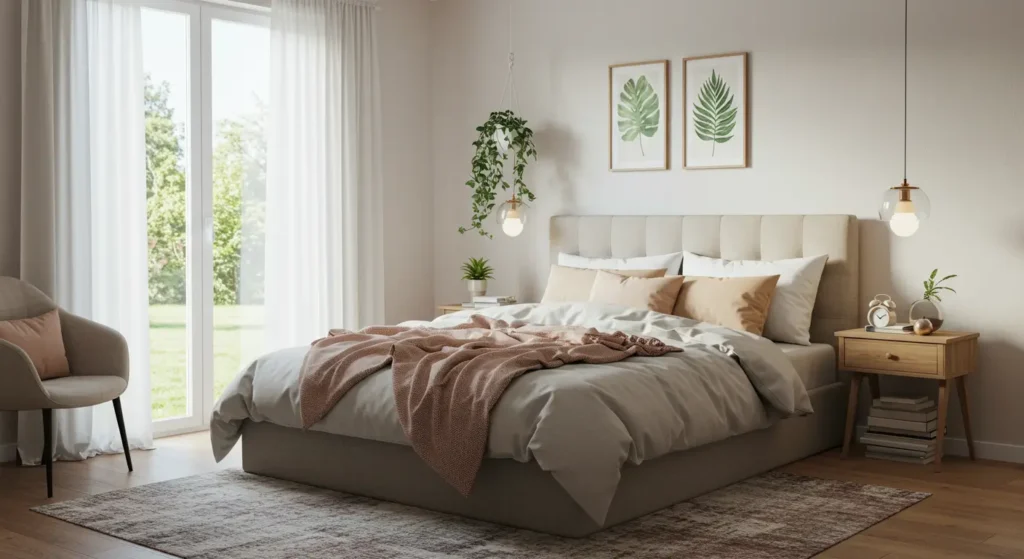Discover Materials That Make Built-In Dining Room Cabinets Last Longer and Look Better
Some cabinets stay solid and stylish for years. Others warp, peel, or crack early. The difference? Material. Choosing the right material improves both how your built-in dining room cabinets look and how long they last.
This guide covers the top materials for built-in dining room cabinets. You’ll see each one’s pros and cons, learn where it works best, and find out which suits your budget and style.
Why the Right Material Matters
Built-in dining room cabinets do more than store plates and glasses. They shape the look of your dining area and help keep things organized. A well-chosen material keeps cabinets strong, easy to clean, and attractive over time.
Using solid wood brings warmth and strength. Plywood offers balance between cost and stability. MDF gives a clean, painted finish. Laminate is affordable and easy to maintain. Veneer gives the look of real wood at a lower price. Stainless steel stands out in modern spaces.
Whether your priority is long-term value, easy upkeep, or visual impact, the material you choose plays a big role. Make the right call, and your cabinets will stay functional and stylish for years.
1. Solid Wood – Strong and Classic
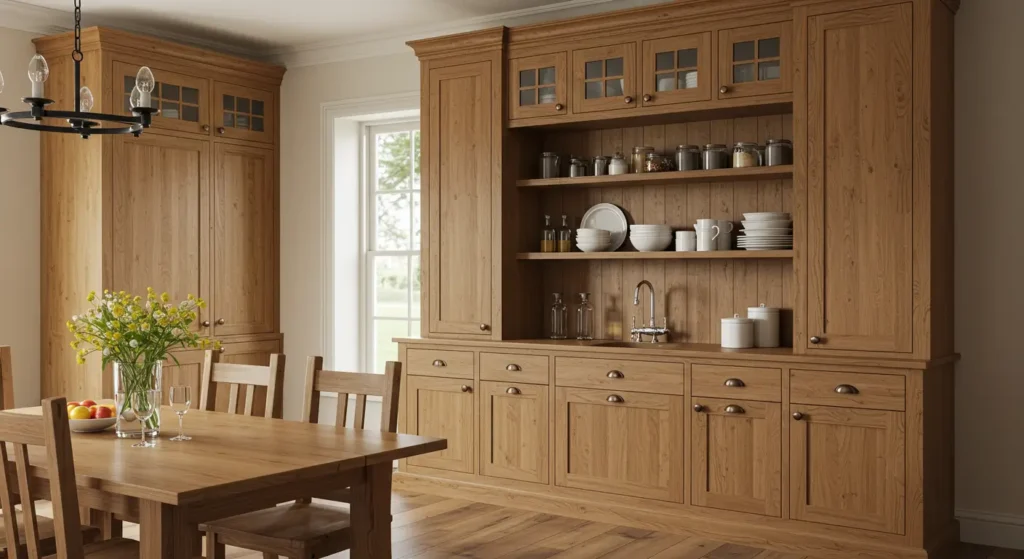
Best for: Traditional, rustic, or farmhouse dining room styles
Keyword focus: solid wood built-in dining room cabinets
Solid wood is a trusted choice for built-in dining room cabinets. It includes hardwoods like oak, maple, cherry, and walnut. These materials are strong, long-lasting, and visually appealing. Solid wood gives your cabinets a natural, warm appearance that suits both traditional and rustic interiors.
Unlike man-made materials, solid wood can be sanded and refinished. This helps extend its life and lets you update the look without replacing the cabinets. It’s a smart option for long-term value.
Pros:
- Durable: Solid wood resists wear and holds weight well.
- Refinishable: You can sand and repaint or stain it multiple times.
- Natural beauty: The grain and color add warmth and style to the room.
Cons:
- Sensitive to moisture: It may expand or shrink with changes in humidity.
- Higher cost: More expensive than MDF, laminate, or plywood.
Summary:
Solid wood built-in cabinets offer timeless style and proven strength. While they cost more, they’re worth it if you want cabinets that last for years and maintain their charm. For homes with a rustic, farmhouse, or classic theme, solid wood is a reliable and attractive material choice.
2. Plywood – Durable and Cost-Effective

Best for: Busy dining areas and custom cabinet builds
Keyword focus: plywood built-in dining room cabinets
Plywood is created by bonding together thin layers of wood veneer. These layers are organized in alternate grain directions to give plywood its strength and stability.This structure helps prevent warping and makes it a great choice for built-in dining room cabinets that need to hold up under daily use.
Whether your dining room style is classic or modern, plywood adapts well. It’s often used in custom cabinetry because it’s both strong and easy to work with. Compared to solid wood, it’s also more affordable—making it a smart option for homeowners who want a reliable material without overspending.
Pros:
- Resists warping: Holds up better than solid wood in changing temperatures or humidity.
- Budget-friendly: Delivers strength and quality at a lower cost.
- Versatile style: Works with many cabinet finishes and design styles.
Cons:
- Needs finishing: Requires proper sealing, painting, or veneering for a smooth and polished appearance.
Summary:
Plywood built-in dining room cabinets offer a strong balance between durability and cost. If you want cabinets that last and look great in a high-traffic dining space, plywood is a dependable and flexible choice. It combines the best of strength, affordability, and design potential—especially for custom builds or remodels.
3. Medium-Density Fiberboard (MDF) – Smooth and Paint-Ready

Best for: Painted cabinets and modern designs
Keyword focus: MDF built-in dining room cabinets
Medium-Density Fiberboard, or MDF, is made by combining fine wood fibers with resin and compressing them into solid panels. This results in a smooth, even surface that is ideal for painting. MDF is a top pick for homeowners aiming for a clean, modern look without spending a lot.
Because MDF has no grain or knots, it accepts paint well and produces a faultless finish. This makes it ideal for sleek, modern dining room cabinetry.It’s also easier to cut and shape than solid wood, which makes it a favorite for decorative cabinet details.
Pros:
- Affordable: A lower-cost alternative to solid wood or plywood.
- Smooth surface: Excellent for painted finishes with no grain or texture showing through.
- Stable: Won’t crack or split like natural wood over time.
Cons:
- Less durable: Not as strong as plywood or solid wood for high-impact areas.
- Sensitive to moisture: Can swell or warp if not properly sealed or painted.
Summary:
MDF built-in dining room cabinets are a great choice if you’re going for a modern, painted look on a budget. While it’s not as tough as solid wood, its smooth surface and ease of customization make it a practical and attractive option—especially in dining spaces where visual style is just as important as function.
4. Laminate – Easy and Stylish
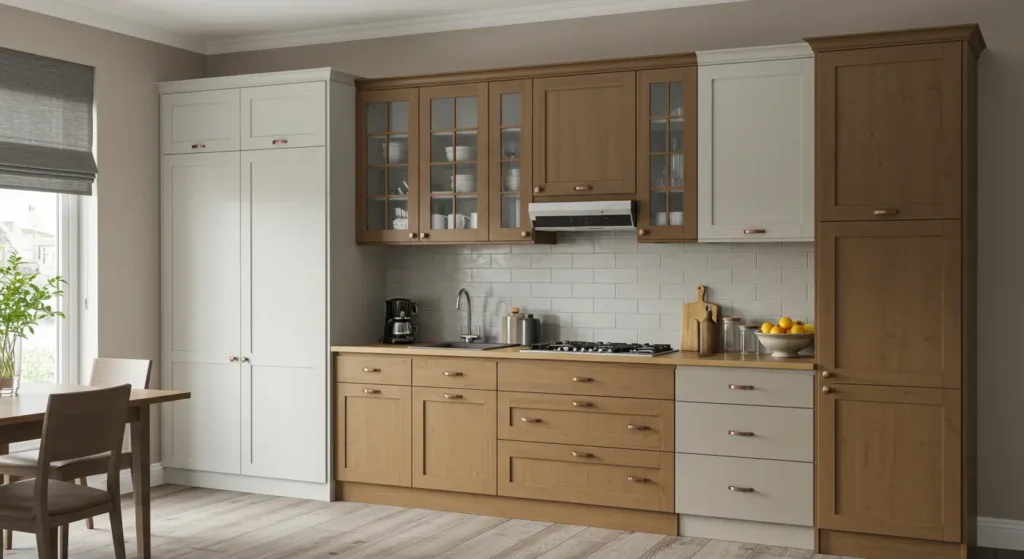
Best for: Families or budget-conscious homeowners
Laminate is a cost-effective and stylish choice for built-in dining room cabinets. It features a decorative surface layer bonded to a core material such as MDF or plywood. This construction gives it strength while offering a wide variety of looks, including wood grain, solid colors, and textured finishes.
Pros:
- Easy to clean: Wipe it down with a damp cloth—ideal for dining rooms that see frequent use.
- Resistant to scratches and moisture: A durable surface makes laminate great for everyday living.
- Many styles and colors: From classic wood tones to bold modern prints, laminate offers flexibility in design.
Cons:
- May chip or peel over time: Especially at the edges or if exposed to excessive moisture.
- Feels less natural than real wood: While it looks good, it doesn’t provide the same texture or richness.
Why It Works:
Laminate strikes a balance between price and performance. It’s perfect for homes where cabinets need to handle messes, movement, and moisture—without constant upkeep. Plus, the style variety lets you match your space without spending a lot.
Whether you’re designing a family-friendly dining area or upgrading on a budget, laminate delivers both looks and convenience. For homeowners who want simplicity with a touch of personality, it’s a top contender.
5. Wood Veneer – Real Look, Lower Cost
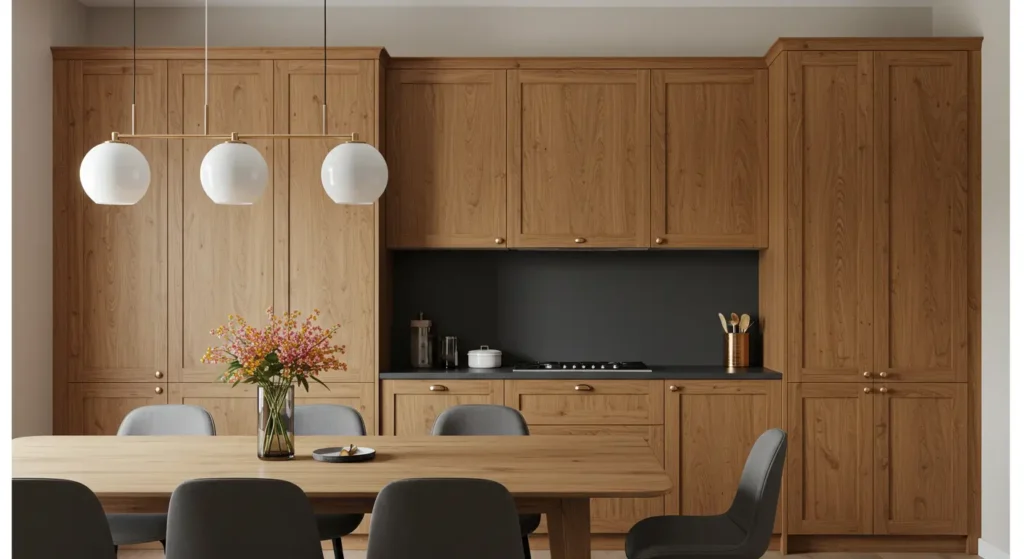
Best for: Homeowners who want wood style without high cost
Wood veneer offers the appearance of solid wood at a fraction of the price. It’s made by layering thin slices of real wood over core materials like MDF or plywood. This gives you the natural grain and texture of wood while keeping costs lower.
Pros:
- Mimics the look of solid hardwood
- More affordable than solid wood
- Easier to use in custom cabinet projects
Cons:
- Can peel or bubble if not cared for properly
- Cannot be sanded or refinished like solid wood
Wood veneer is a smart option if you want the warmth of wood without the high price. With proper care, it offers both style and value for your built-in dining room cabinets.
6. Stainless Steel – Modern and Clean
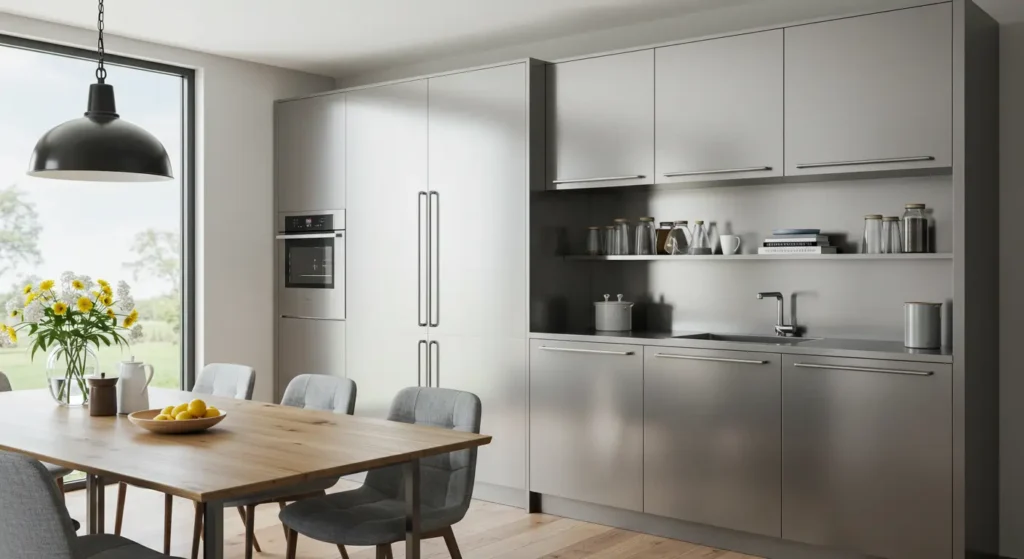
Best for: Modern or industrial designs
Stainless steel is a strong, sleek material that gives dining rooms a bold, modern feel. It’s often used in professional kitchens because of its durability and resistance to heat and moisture. This makes it a smart choice for built-in dining room cabinets—especially in homes that value style and performance.
Pros:
- Durable and long-lasting
Stainless steel won’t crack, warp, or break. It stays strong even with frequent use. - Water-resistant
It handles spills and moisture without damage, making it easy to maintain - Modern and polished look
Its smooth, reflective surface brings a clean and upscale feel to any dining space.
Cons:
- Shows fingerprints easily
The reflective surface makes smudges more visible and may need frequent wiping. - More expensive than other materials
Stainless steel costs more upfront, but its durability often offsets the long-term cost.
Why Choose Stainless Steel?
Stainless steel is ideal for homeowners who want their dining room to look modern and stay low-maintenance. It fits perfectly in minimalist and industrial themes, where clean lines and function matter most. While it’s not the cheapest option, it offers excellent long-term value.
For families who love entertaining or simply want a clean and contemporary look, stainless steel delivers both style and strength—without compromising on practicality.
Key Factors to Consider
Before picking a material for your built-in dining room cabinets, keep a few important things in mind:
- Budget:
Solid wood and stainless steel cost more upfront. If you want to save, consider MDF or laminate. - Usage:
For cabinets that will be used daily, plywood and laminate are smart, durable choices. - Style Preferences:
Solid wood or wood veneer offer a warm, traditional feel. For a clean, modern look, choose MDF or stainless steel. - Maintenance:
If you prefer low-effort upkeep, laminate and stainless steel are great choices—they’re both easy to clean and maintain..
In Conclusion, Choose what fits your space, your budget, and your style. The right choice makes your dining room more beautiful—and more functional—for years to come.


